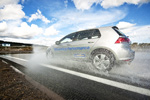 "Beyond the label" was the theme for the launch of the Goodyear EfficientGrip replacement, the Goodyear EfficientGrip Performance, but instead of just talking about the 3/15/50 message, we actually got to test two different brands of B/A labelled tyres back to back in wet handling and curved aquaplaning.
"Beyond the label" was the theme for the launch of the Goodyear EfficientGrip replacement, the Goodyear EfficientGrip Performance, but instead of just talking about the 3/15/50 message, we actually got to test two different brands of B/A labelled tyres back to back in wet handling and curved aquaplaning.
Straight to the driving
It’s no real surprise that the new EfficientGrip Performance improves on the outgoing EfficientGrip, and with more than 60% of its launch sizes getting a BA label score (rolling resistance / wet grip) it is one of the highest rated tyres ranges on the market.
The real surprise came from how differently two tyres with the same BA rating, delivered performance and grip in other areas.
Testing against the excellent Michelin Energy Saver+ in identical cars, the new EfficientGrip Performance had a clear advantage in both curved aquaplaning and wet handling.
During the curved aquaplaning tests we drove two VW Golfs in a constant radius at 80kph and entered an area of 8mm water depth. Without changing the steering inputs, lasers measured the lateral deviation of the car caused by aquaplaning. The Goodyear averaged 3.4 meters over 20 runs, while the Michelin drifted a further 1.2 meters, averaging 4.6 meters.
 The wet comparison testing was even more interesting. On a permanently soaked wet handling track at an average of 1mm water depth, we used the new Mercedes A Class to test the Michelin VS the Goodyear.
The wet comparison testing was even more interesting. On a permanently soaked wet handling track at an average of 1mm water depth, we used the new Mercedes A Class to test the Michelin VS the Goodyear.
While their initial turn in and wet braking felt broadly similar, a reflection of their matching A label scores, everything else felt drastically different. Once you started to near the limit the Michelin understeered much earlier, with the rear being upset earlier than on the Goodyear by slightly deeper sections of water. Braking into corners, the Michelin was much harder to get turned while slightly trail braking, where the Goodyear darted in without fuss. Low speed stability was again an issue, with the rear stepping out much earlier on the Michelin, and the reduced traction on corner exit leaving the traction control and ESP systems working overtime when enabled.
In short, despite their matching A wet braking scores, there’s much more to a tyre in all round performance to inspire safety and confidence, and in this comparison at least, the new Goodyear had the clear advantage.
How has this been achieved?
To achieve the BA labelling scores, while not compromising the tyres performance in any other of the 50+ areas tested, Goodyear have introduced a number of new technologies into the EfficientGrip Performance.
Wear Control technology balances out wear across the surface of the tyre which helps deliver a more optimised wet grip and rolling resistance throughout the tyres life, while a new compound and shoulder construction reduces heat build up in the tyre to further help wear and rolling resistance.
Active braking technology helps reduce the tyres wet and dry braking throughout the life of the tyre by creating a 3D block design which increases the tyres contact with the road during hard braking.
While a continuous centre rib increases cornering stiffness, which improves the tyres steering response and and vehicle control.
Available from 14" to 18", the new EfficientGrip Performance is initially offered in 39 sizes in Europe.







